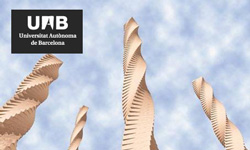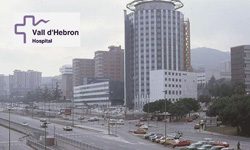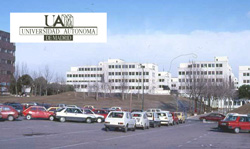Comportamiento dinámico e interacciones de proteínas implicadas en la transducción de señales
 2014-
2014-
INVESTIGADOR
Dirección: Jordi Villà-Freixa
Lab. de Bioquímica y Biofísica Computacional (CBBL)
Facultad de Ciencias y Tecnología & Facultad de Medicina
Universidad de Vic – Universidad Central de Cataluña
Introducción: Nuestro principal objetivo es, mediante el uso de técnicas de simulación y otras técnicas de bioinformática estructural, comprender el proceso de activación de sistemas proteicos a nivel atómico; lo que posteriormente nos puede permitir el descubrimiento de pequeñas moléculas capaces de modular este proceso.
Algunos resultados:
a) Descripción del sitio de unión para el agonista YC-1 en la guanilato ciclasa soluble.
b) La substitución R92Q en el receptor de TNF 1 resulta en una interacción más fuerte entre este receptor y el TNF.
Publicaciones principales:
1.- Agulló L, Malhotra S, Fissolo N, Montalban X, Comabella M. Molecular dynamics and intracellular signaling of the TNF-R1 with the R92Q mutation. J Neuroimmunol 289: 12–20 (2015)
2.- Agulló L, Buch I, Gutiérrez-de-Terán H, Garcia-Dorado D, Villà-Freixa J. Computational exploration of the binding mode of heme-dependent stimulators into the active catalytic domain of soluble guanylate cyclase. Proteins 84:1534-48 (2016)
3.- Molinos-Albert LM, Bilbao E, Agulló L, Marfil S, García E, Concepción ML, Izquierdo-Useros N, Vilaplana C, Nieto-Garai JA, Contreras FX, Floor M, Cardona PJ, Martinez-Picado J, Clotet B, Villà-Freixa J, Lorizate M, Carrillo J, Blanco J. Proteoliposomal formulations of an HIV-1 gp41-based miniprotein elicit a lipid-dependent immunodominant response overlapping the 2F5 binding motif. Sci Rep 7:40800 (2017)
Señalización celular en la Esclerosis Múltiple
 2010-2013
2010-2013
INVESTIGADOR
Dirección: Xavier Montalbán
Laboratorio de Neuroinmunologia Clínica, Centro de Esclerosis Múltiple de Cataluña (CEM-Cat)
Instituto de Investigación Vall d’Hebron
Introducción: El receptor 1 del TNF parecía tener una función clave en la respuesta autoinmune. Algunos pacientes de esclerosis múltiple presentaban mutaciones en este receptor. Nuestro objetivo fue intentar entender como algunas de las mutaciones más frecuentes en este receptor afectaban al curso de la enfermedad.
Resultados:
a) La substitución R92Q reduce la edad de inicio de la esclerosis múltiple, pero ralentiza su progresión.
Publicaciones principales:
1.- Comabella M, Caminero AB, Malhotra S, Agulló L, et al. TNFRSF1A polymorphisms rs1800693 and rs4149584 in patients with multiple sclerosis. Neurology 80: 2010-6 (2013)
Papel del sistema NO/cGMP en el infarto de miocardio
 1997-2010
1997-2010
2nd POSTDOC – INVESTIGADOR
Dirección: David Garcia-Dorado
Laboratorio de Cardiología Experimental
Instituto de Investigación
Vall d’Hebron
Introducción: Los datos sobre el efecto del NO (o de donadores del mismo) en el infarto de miocardio y sobre los mecanismos por los que actuaba eran contradictorios al comienzo del estudio. Por otro lado, no existía prácticamente ninguna información sobre el funcionamiento del sistema de transducción NO/cGMP en el corazón durante la isquemia miocárdica y la reperfusión. Tampoco se conoce bien cómo se regula la síntesis de GMP cíclico en el tejido miocárdico en condiciones fisiológicas.
Resultados:
a) La síntesis de GMP cíclico disminuye durante la isquemia y reperfusión miocárdicas.
b) La administración de sustancias que estimulan la síntesis de GMP cíclico al finalizar la oclusión coronaria normaliza los niveles de GMP cíclico endógenos y reduce el tamaño del infarto. Por otro lado, los efectos beneficiosos del NO en estos mismos modelos parecen ser mediados por el GMP cíclico.
c) Por primera vez en cardiomiocitos se ha encontrado que una fracción significativa del enzima guanilil ciclasa ‘soluble’ se encuentra asociada a membrana. Además, los estudios de correlación realizados indican que la síntesis de GMP cíclico en estas células podría depender en su mayor parte de esta fracción del enzima localizado en membrana.
Publicaciones principales:
1.- Agulló L, García-Dorado D, Inserte J et al. L-Arginine limits myocardial cell death secondary to hypoxia-reoxygenation by a cGMP dependent mechanism. Am J Physiol Heart Circ Physiol 276: H1574-H1580 (1999)
2.- Agulló L, García-Dorado D, Escalona N et al. Effect of ischemia on soluble and particulate guanylyl cyclase-mediated cGMP synthesis on cardiomyocytes. Am J Physiol Heart Circ Physiol 284: H2170-H2176 (2003)
3.- Agulló L, Garcia-Dorado D, Escalona N et al. Membrane-association of nitric oxide-sensitive guanylyl cyclase in cardiomyocytes. Cardiovasc Res 68: 65-74 (2005)
Sistema de transducción óxido nítrico(NO)/GMP cíclico en células gliales
 1986-1997
1986-1997
PhD – 1st POSTDOC
Dirección: Agustina García, Fernando Picatoste
Laboratorio de Neuroquímica, Institut de Biologia Biomédica (IBB), Departamento de Bioquímica i Biología Molecular
Universidad Autónoma de Barcelona (UAB)
Introducción: En los inicios del estudio del óxido nítrico (NO) en el sistema nervioso (principio de la década de los 90) se asumía que únicamente las neuronas contenían NO sintasa.
Resultados:
a) Las células gliales, en contra de lo que se asumía en el momento del estudio, también contienen NO sintasa constitutiva (aparentemente similar a la neuronal, NOS1).
b) A pesar de que el enzima es indistinguible in vitro del neuronal, la síntesis de NO es modulada de forma diferente en células gliales y neuronas.
c) La actividad del sistema de transducción NO/cGMP glial varía en distintas zonas del sistema nervioso central, siendo especialmente relevante en el cerebelo.
Publicaciones principales:
1.- Agulló L, García A. Different receptors mediate stimulation of nitric oxide-dependent cyclic GMP formation in neurons and astrocytes in culture. Biochem Biophys Res Commun 182: 1362-1368 (1992)
2.- Agulló L, García A. Characterization of noradrenaline-stimulated cyclic GMP formation in brain astrocytes in culture. Biochem J 288: 619-624 (1992)
3.- Murphy S, Simmons ML, Agulló L et al. Synthesis of nitric oxide in CNS glial cells. Trend Neurosci 16: 323-328 (1993)
Formación en la supervisión del laboratorio clínico
 1986-1989
1986-1989
RESIDENCIA MÉDICA (Q.I.R.)
Dirección: Simon Schwartz, Lluis Arcalís
Depts. Bioquímica Clínica, Hematología y Microbiología
Hospital Universitari Vall d’Hebron
Sistemas de transporte de aminoácidos neurotransmisores
 1984-1985
1984-1985
MASTER (Tesina)
Dirección: Carmen Aragón & Cecilio Giménez
Departamento de Bioquímica y Biología Molecular – Centro de Biología Molecular ‘Severo Ochoa’
Universidad Autónoma de Madrid (UAM)
Introducción: Ciertos datos indicaban la existencia de liberación de aminoácidos neurotransmisores de manera independiente de Ca2+ en los terminales sinápticos. Se discutía la posibilidad de la implicación de los sistemas de transporte hacia el interior celular en este proceso.
Resultados:
a) Los sistemas de transporte de los aminoácidos neurotransmisores podrían participar en su liberación durante la transmisión sináptica (funcionando de manera inversa como sistemas de eflujo).
Publicaciones principales:
1.- Agulló L, Jiménez B, Aragón C et al. ß-Alanine transport in synaptic plasma membrane vesicles from rat brain: efflux, exchange and stoichiometry. Eur J Biochem 159: 611-617 (1986)










